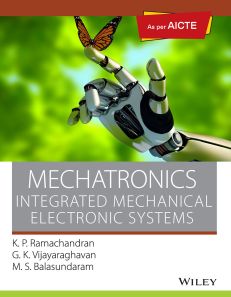Mechatronics, As per AICTE: Integrated Mechanical Electronic Systems
ISBN: 9788126540402
Publication Year: 2019
For more information write to us at: acadmktg@wiley.com

Description
Mechatronics is a rapidly developing interdisciplinary field of engineering. The mechatronics deals with the synergistic integration of mechanical engineering, electronic engineering, computer technology and control engineering in the development of electromechanical products, through an integrated design approach. The utility of the microcomputer and other similar microprocessor-based devices have been employed in countless applications to the system monitoring, data handling, data presentation and control. The modern mechanical engineer must therefore, be competent in the application of microprocessor-based systems.
Chapter 1 Mechatronics Systems
1.1 Elements of Mechatronics System
1.2 Mechatronics Design Process
1.3 System
1.4 Measurement Systems
1.5 Control Systems
1.6 Microprocessor-based Controllers
1.7 Real-time Mechatronics Systems
1.8 Other Applications
1.9 Advantages and Disadvantages of Mechatronics Systems
Chapter 2 Sensors and Transducers
2.1 Introduction
2.2 Types of Transducers
2.3 Characteristic Parameters Used in Transducers
2.4 Displacement Sensors
2.5 Position Sensors
2.6 Proximity Sensors
2.7 Velocity Sensors
2.8 Motion Sensors
2.9 Force Sensors
2.10 Acceleration Sensors
2.11 Torque Sensors
2.12 Fluid Pressure Sensors
2.13 Liquid Flow Sensor
2.14 Liquid-level Sensors
2.15 Temperature Sensors
2.16 Light Sensors
2.17 Digital Transducer
2.18 Selection of Sensors
Chapter 3 Solid-State Electronic Devices
3.1 Solid-State Electronics
3.2 PN Junction Diode
3.3 Bipolar Junction Transistor (BJT)
3.4 Field-Effect Transistor (FET)
3.5 Thyristors
3.6 Diode AC Switch (DIAC) and Triode AC Switch (TRIAC)
3.7 Light-Emitting Diodes and Optical Isolation
Chapter 4 Analog Signal Conditioning
4.1 Signal Conditioner
4.2 Operational Amplifier (Op-amp)
4.3 Noise Reduction
4.4 Bridge Circuits
4.5 Current-to-Voltage and Voltage-to-Current Converters
4.6 Voltage-to-Frequency and Frequency-to-Voltage Converters
Chapter 5 Hydraulic and Pneumatic Actuating Systems
5.1 Fluid Power Systems
5.2 Hydraulic Systems
5.3 Pneumatic System
5.4 System Structure and Signal Flow
5.5 Hydraulic Pumps and Pressure Regulation
5.6 Air Compressors, Air Treatment and Pressure Regulation
5.7 Control Valves
5.8 Actuator and Output Devices
5.9 Electro-Pneumatics
5.10 Pneumatic and Hydraulic Circuits
5.11 Cylinder Sequencing and Cascade Control
5.12 Process Control Valves
Chapter 6 Mechanical Actuating Systems
6.1 Introduction
6.2 Types of Motion
6.3 Degrees of Freedom
6.4 Constraints
6.5 Kinematic Chains
6.6 Cams
6.7 Gears and Gear Trains
6.8 Ratchet and Pawl
6.9 Belt Drive
6.10 Chain Drive
6.11 Bearings
6.12 Preload
Chapter 7 Electrical Actuating Systems
7.1 Basic Principles of Electrical Switching
7.2 Solenoids
7.3 Electrical Relays
7.4 Representation of Output Devices
7.5 Electrical Motors
7.6 AC Motors
7.7 Stepper Motor
7.8 Induction Motor Speed Control
Chapter 8 Digital Electronics and Systems
8.1 Digital Logic Control
8.2 Microprocessors and Microcontrollers
8.3 Programming
Chapter 9 System Interfacing and Data Acquisition
9.1 Data Acquisition Systems (DAQS)
9.2 I/O Hardware and Software at the Microprocessor Level and Communication
9.3 Analog-to-Digital and Digital-to-Analog Conversions
9.4 Digital Signal Processing (DSP)
9.5 Data Flow in DSPs, Block Diagrams and Typical Layouts
9.6 Component Interconnection and Impedance Matching
9.7 Interfacing Motor Drives
9.8 Electrical Power Supply and Protection
Chapter 10 Dynamic Models
10.1 Block Diagrams
10.2 Laplace Transforms
10.3 Transfer Function
10.4 Block Diagram Simplification
10.5 Dynamic Models and Analogies
Chapter 11 System Response
11.1 Static Response
11.2 Poles, Zeros and Stability
11.3 Time Response
11.4 Frequency Response
Chapter 12 Process Controllers
12.1 Controller Principles
12.2 Two-Position Controller (ON/OFF Controller)
12.3 Proportional Controllers
12.4 Integral Controller
12.5 Derivative Controller
12.6 Composite Controller Modes
12.7 Pneumatic Controllers
12.8 Selection of Controllers
12.9 PID Controller Tuning
12.10 Digital Controllers
12.11 Adaptive Controllers
Chapter 13 Programmable Logic Controllers
13.1 Introduction to PLCs
13.2 Basic Structure of a PLC
13.3 Principles of Operation
13.4 PLCs versus Computers
13.5 Introduction to Internal Architecture and Hardware Components
13.6 PLC Programming
13.7 ANALOG I/O
13.8 Selecting a PLC for the Application
13.9 Application of PLCs for Control
Chapter 14 Introduction to CNC Machines and Robotics
14.1 CNC Machines
14.2 Robotics
Chapter 15 Design of Mechatronics Systems
15.1 Introduction
15.2 Mechatronics Approach to Design
15.3 Case Examples
15.4 Future trends - Smart Homes
Summary
Key Terms
Review Questions
Index

